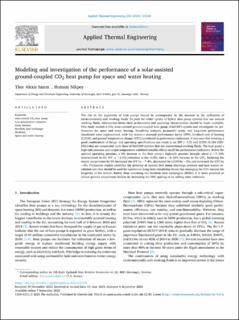| dc.contributor.author | Sazon, Thor Alexis Salazar | |
| dc.contributor.author | Nikpey Somehsaraei, Homam | |
| dc.date.accessioned | 2023-12-04T09:21:32Z | |
| dc.date.available | 2023-12-04T09:21:32Z | |
| dc.date.created | 2023-10-01T12:11:13Z | |
| dc.date.issued | 2023 | |
| dc.identifier.citation | Sazon, T. A., & Nikpey, H. (2024). Modeling and investigation of the performance of a solar-assisted ground-coupled CO2 heat pump for space and water heating. Applied Thermal Engineering, 236, 121546. | en_US |
| dc.identifier.issn | 1359-4311 | |
| dc.identifier.uri | https://hdl.handle.net/11250/3105755 | |
| dc.description.abstract | The rise in the popularity of heat pumps should be accompanied by the increase in the utilization of environmentally-safe working fluids. To push for wider uptake of hybrid heat pump systems that use natural working fluids, information about their performance and operating characteristics should be made available. This study models a CO2 solar-assisted ground-coupled heat pump (SAGCHP) system and investigates its performance for space and water heating. Sensitivity analysis, parametric study, and long-term performance simulation were implemented, with the system’s seasonal performance factor (SPF), levelized cost of heating (LCOH), and ground temperature change (GTC) considered as performance indicators. It was seen that ensuring a good combination of design and operating specifications can result in an SPF (∼3.5) and LCOH (0.184 USD/kWh) that are comparable with those of SAGCHP systems that use conventional working fluids. The heat pump’s high-side pressure and output temperature exhibited notable effects on all the performance indicators. Below the optimal operating pressure, a 5% increase in the heat pump’s high-side pressure brought about a ∼7–10% improvement to the SPF, a ∼3–5% reduction to the LCOH, and a ∼6–10% increase to the GTC. Reducing the output temperature by 5% increased the SPF by ∼7–8%, decreased the LCOH by ∼3%, and increased the GTC by ∼6%. Parametric studies identified the presence of optimal heat pump discharge pressure and heat source circulation rate that should be used for operations. Long-term simulation shows that managing the GTC ensures the longevity of the system. Rather than oversizing the borehole heat exchangers (BHEs), it is more practical to reduce ground temperature decline by increasing the BHE spacing or by adding solar collectors. | en_US |
| dc.language.iso | eng | en_US |
| dc.publisher | Elsevier | en_US |
| dc.rights | Navngivelse 4.0 Internasjonal | * |
| dc.rights.uri | http://creativecommons.org/licenses/by/4.0/deed.no | * |
| dc.title | Modeling and investigation of the performance of a solar-assisted ground-coupled CO2 heat pump for space and water heating | en_US |
| dc.type | Peer reviewed | en_US |
| dc.type | Journal article | en_US |
| dc.description.version | publishedVersion | en_US |
| dc.rights.holder | © The Author(s) 2023 | en_US |
| dc.subject.nsi | VDP::Teknologi: 500 | en_US |
| dc.source.journal | Applied Thermal Engineering | en_US |
| dc.identifier.doi | 10.1016/j.applthermaleng.2023.121546 | |
| dc.identifier.cristin | 2180654 | |
| cristin.ispublished | true | |
| cristin.fulltext | original | |
| cristin.qualitycode | 1 | |

